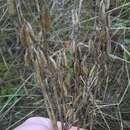Comprehensive Description
provided by North American Flora
Tium arrectum (A. Gray) Rydb. Bull. Torrey Club 40:49. 1913.
Astragalus leucophyllus Hook. Lond. Jour. Bot. 6: 211. 1847. Not A. leucophyllus Willd. 1803.
Astragalus arrectus A. Grav, Proc. Am. Acad. 8: 289. 1870.
Astragalus palousensis Piper. Bot. Gaz. 22: 489. 1896.
Astragalus arrectus palousensis M. E. Jones, Contr. W. Bot. 10: 68. 1902.
Phaca arrecla Piper, Contr. U. S. Nat. Herb. 11: 371. 1906.
A cespitose perennial, with woody root and short caudex; stems several, 3-6 dm. high, sulcate or angled, sparingly strigose; leaves ascending, 7-15 cm. long, the rachis strigose; stipules deltoid, acuminate, spreading or reflexed; leaflets 13-31, linear or oblong, or those of the lower leaves obovate, 8-20 mm. long, 2-5 mm. wide, obtuse, rounded, or rarely retuse at the apex, glabrous above, strigose beneath; peduncles 1-2 dm. long; racemes 4—10 cm. long; bracts lanceolate, 3-5 mm. long, black-hairy; pedicels 1-2 mm. long; calyx black-hairy, the tube 4—5 mm. long, 3-4 mm. broad; corolla white or ochroleucous, 14—15 mm. long; banner obovate, moderately arched at the middle; wings slightly longer, the blade oblanceolate, slightly falcate, with a very large reflexed auricle; keel-petals shorter, broadly obliquely lunate, abruptly arched above the middle, with a small auricle ; pod strigose, or in age glabrate, the stipe 4—5 mm. long; body oblong, abruptly acute at each end, obtuse on the upper suture, sulcate on the lower, about 15 mm. long, 4 mm. wide and thick, the cross-section broadly cordate, the septum less than 1 mm. wide.
Type locality: Kooskooski River, Idaho.
Distribution: Idaho, and western Washington and Oregon.
- bibliographic citation
- Per Axel Rydberg. 1919. (ROSALES); FABACEAE; PSORALEAE. North American flora. vol 24(1). New York Botanical Garden, New York, NY
Physical Description
provided by USDA PLANTS text
Perennial, Herbs, Stems woody below, or from woody crown or caudex, Taproot present, Nodules present, Stems erect or ascending, Stems less than 1 m tall, Stems solid, Stems or young twigs sparsely to densely hairy, Stem hairs hispid to villous, Leaves alternate, Leaves petiolate, Stipules conspicuous, Stipules membranous or chartaceous, Stipules persistent, Stipules free, Leaves compound, Leaves odd pinnate, Leaf or leaflet margins entire, Leaflets opposite, Leaflets 10-many, Leaves hairy on one or both surfaces, Inflorescences racemes, Inflorescence axillary, Bracts very small, absent or caducous, Flowers zygomorphic, Calyx 5-lobed, Calyx glabrous, Petals separate, Corolla papilionaceous, Petals clawed, Petals ochroleucous, cream colored, Banner petal narrow or oblanceolate, Wing petals narrow, oblanceolate to oblong, Wing tips obtuse or rounded, Keel petals auriculate, spurred, or gibbous, Keel tips obtuse or rounded, not beaked, Stamens 9-10, Stamens diadelphous, 9 united, 1 free, Filaments glabrous, Style terete, Style persistent in fruit, Fruit a legume, Fruit stipitate, Fruit freely dehiscent, Fruit oblong or ellipsoidal, Fruit or valves persistent on stem, Fruit fleshy, Fruit coriaceous or becoming woody, Fruit exserted from calyx, Fruit beaked, Fruit glabrous or glabrate, Fruit 11-many seeded, Seeds cordiform, mit-shaped, notched at one end, Seed surface smooth, Seeds olive, brown, or black.

